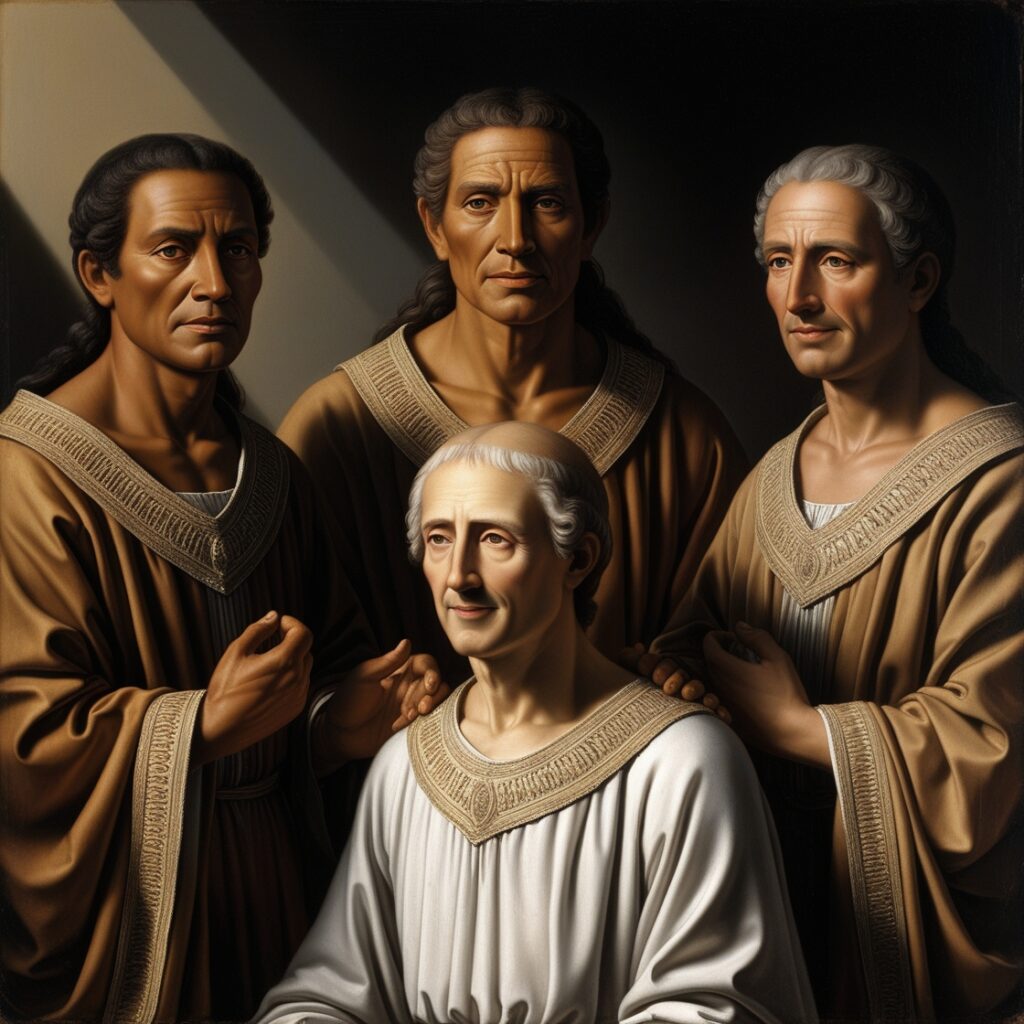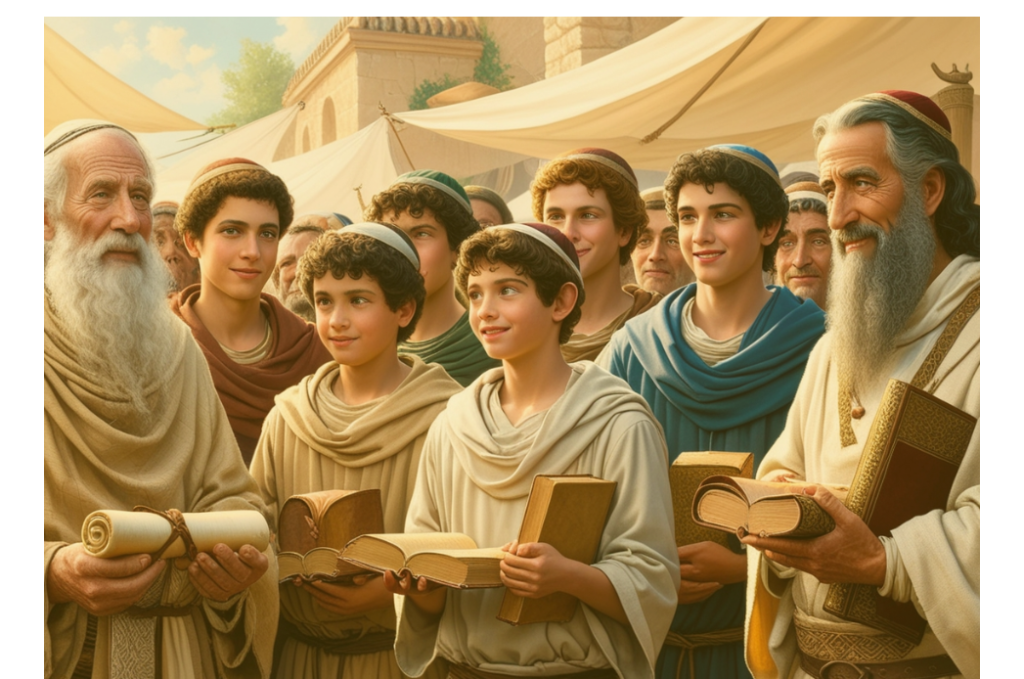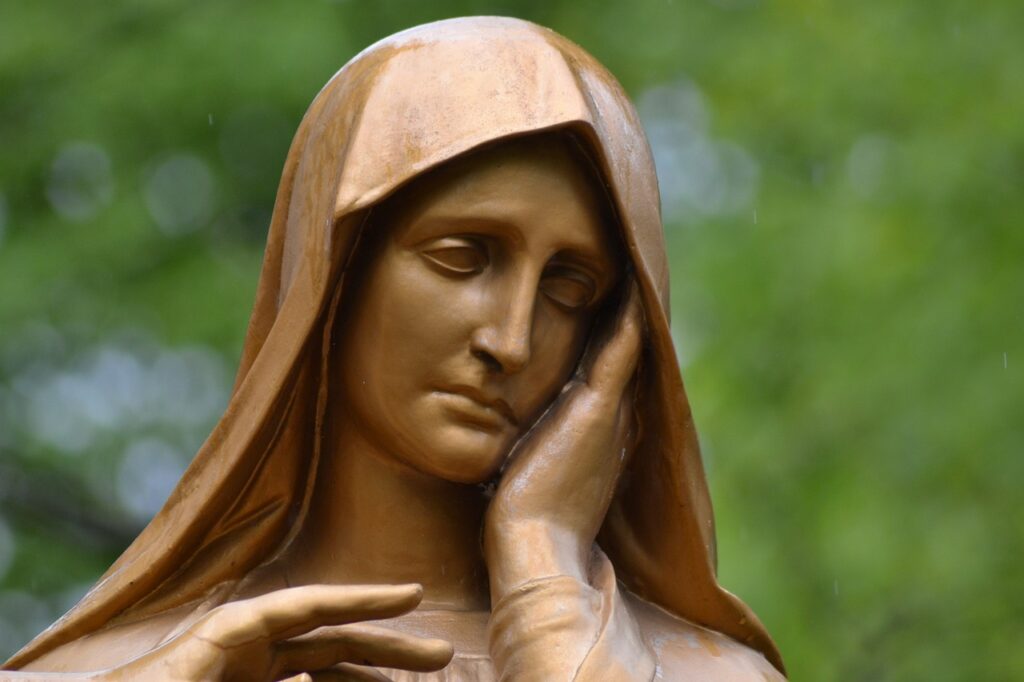Here’s Something I’ve Been Wondering…A Question For the Latter-day Saint
1. Your church teaches the “Great Apostasy”. The priesthood authority was lost.[1]
“After the Apostles were killed, there was a widespread falling away from the gospel and Church of Jesus Christ. This falling away is sometimes called the Great Apostasy. Because of it, God withdrew priesthood authority from the earth.” [2]
“After the deaths of the Savior and His Apostles, men corrupted the principles of the gospel and made unauthorized changes in Church organization and priesthood ordinances. Because of this widespread apostasy, the Lord withdrew the authority of the priesthood from the earth.” [3]
2. You also teach that John the Apostle and the Three Nephites were granted power to remain on earth and continue ministering until the Second Coming. (D&C 7:2, 3 Nephi 28:9)
In fact, they are still alive to this day. [4]
They held the Melchizedek Priesthood. For the three Nephites (3 Nephi 11–12, 3 Nephi 19:4, 3 Nephi 18:36, 3 Nephi 28:1–9). And John (JSH 1:72).
So, how can it be said that the priesthood was completely removed from the earth? If these four men were alive and held priesthood authority throughout that period, wouldn’t that contradict the idea of a total apostasy? And if they didn’t hold the priesthood keys needed to lead the Church or perform saving ordinances, then what was the point of them ministering for all those centuries?
Did the Three Nephites Have Priesthood Power?
For those not familiar with the Book of Mormon, Jesus Calls the Twelve Nephite Disciples. In 3 Nephi 11:18-22, Jesus first calls Nephi, then gives him authority, and then calls others:
“And the Lord said unto him: I give unto you power that ye shall baptize this people… And again the Lord called others, and said unto them likewise; and he gave unto them power to baptize.”
Then we get the full list of the twelve disciples later.
The Full List of the Twelve Is Given
3 Nephi 19:4 provides the names of all twelve disciples:
“And it came to pass that on the morrow, when the multitude was gathered together, behold, Nephi and his brother whom he had raised from the dead, whose name was Timothy, and also his son, whose name was Jonas, and also Mathoni, and Mathonihah, his brother, and Kumen, and Kumenonhi, and Jeremiah, and Shemnon, and Jonas, and Zedekiah, and Isaiah—now these were the names of the disciples whom Jesus had chosen—and it came to pass that they went forth and stood in the midst of the multitude.”
So we now know exactly who the twelve were. As one BYU Article puts it:
“At one point Mormon was about to write the names of the Three Disciples, but the Lord forbade it (3 Nephi 28:24–25). We have the names of the twelve Nephite Disciples recorded in 3 Nephi 19:4, but as to the identity of the specific three, the Lord has yet to make them known.”[5]
The “Three Nephites” Were Part of That Group
Now look at 3 Nephi 28:1:
“And it came to pass that when Jesus had said these words, he spake unto his disciples, one by one, saying unto them: What is it that ye desire of me…?”
This is the same group of twelve from earlier.
In 3 Nephi 28:3–9, nine of them ask to go quickly to Christ after their ministry. But then in verses 4–9, three of them request to tarry on the earth, 3 Nephi 28:6:
“And he said unto them: Behold, I know your thoughts, and ye have desired the thing which John, my beloved, who was with me in my ministry before that I was lifted up by the Jews, desired of me.”
And in verse 9:
“And again, ye shall not have pain while ye shall dwell in the flesh, neither sorrow save it be for the sins of the world; and all this will I do because of the thing which ye have desired of me, for ye have desired that ye might bring the souls of men unto me, while the world shall stand.”
And in verse 12 we see the Holy Scripture of The Book of Mormon tell us what the three nephites were to Tarry.
“And it came to pass that when Jesus had spoken these words, he touched every one of them with his finger save it were the three who were to tarry, and then he departed.”
Thus, we can confidently conclude that the Three Nephites were part of the twelve disciples personally chosen by Jesus in the Americas. They were explicitly given priesthood authority to baptize and were granted the divine commission to “tarry” on the earth and bring souls to God until His return (see 3 Nephi 28:9). This mirrors the mission of John the Apostle, who was likewise granted power to remain and continue prophesying to the nations (D&C 7:2–3). While it’s unlikely that any Latter-day Saint would deny that John held the Melchizedek Priesthood, for the sake of clarity, Joseph Smith–History 1:72 confirms it.
How Is This Claim Usually Answered?
From official church manuals and sources, the great apostasy is defined essentially as: The time after the Apostles were killed, and priesthood authority, including the keys to direct and receive revelation for the Church, were taken from the earth.
See the following resources to find a common definition:
The Gospels Topics essay on Apostacy:
Latter-day Saints believe that, through the priesthood conferred to Joseph Smith by the ministering of angels, the authority to act in God’s name was brought back to the earth. This is “restored,” not “reformed,” Christianity. Their belief in a restored Christianity helps explain why most Latter-day Saint converts, from the 1830s to the present, converted from other Christian denominations. None of these converts thought they were leaving Christianity; they are simply grateful to learn about, and become part of, the restored Church of Jesus Christ, which they believe offers a more complete and rich Christian Church spiritually, organizationally, and doctrinally….“no one had the authority to confer the gift of the Holy Ghost or perform other priesthood ordinances.”
“Use questions like the following to discuss what students learned from these verses. As part of this discussion, it may be important to explain that although the Savior’s Church and authority were not on the earth during the Great Apostasy, there were many individuals living during that time who loved God and strived to faithfully follow Him according to the understanding they had.”
1. To Define or Re-define What Apostasy Means.
“The priesthood keys were taken from the earth (no one authorized to perform saving ordinances)”.
“The Church of Christ, as an organized institution, ceased to exist.”
“Revelation through prophets ceased the heavens were closed to ongoing direction.”
“Ordinances were corrupted or lost (e.g., baptism, sacrament, temple rites).”
“The fullness of the gospel was no longer taught in its purity or authority.”
2. The “They Were Removed, Like in Mormon 1!” Argument
In Mormon 1:13–14, we are told that the gifts of the Spirit and the priesthood ceased among the Nephites due to their wickedness:
“…the Holy Ghost did not come upon any, because of their wickedness and unbelief.”
And in verse 16, we read:
“…the beloved disciples were taken away out of the land, because of their iniquity.”
From this, some LDS apologists conclude that God withdrew the priesthood from the earth entirely as part of a broader, worldwide apostasy.
Why the “They Were Removed Like in Mormon 1” Defense Fails
This interpretation quickly breaks down. Nowhere in Mormon 1 is there any suggestion of a global withdrawal of priesthood authority. The passage describes a localized consequence: the priesthood was withheld from a specific group of people, not from the entire world. Yet in LDS discourse, this event is often generalized into a sweeping theological claim.
In defending the doctrine of the Great Apostasy, Latter-day Saints frequently assert that “the Lord withdrew the authority of the priesthood from the earth.” But this is not a claim about reduced visibility or temporary concealment. It is an absolute assertion that no one on earth held valid priesthood authority during that period. The Gospel Topics essay is explicit:
“Because of this widespread apostasy, the Lord withdrew the authority of the priesthood from the earth.” [3]
This does not imply dormancy or seclusion. It declares a complete absence of priesthood authority. And yet, LDS teaching simultaneously affirms:
“The Lord granted to these disciples the same blessing granted to John the Beloved—that they might stay on the earth to bring souls to Christ until the Lord comes again.” [6]
This creates an immediate contradiction.
Invoking Mormon 1:16 Only Deepens the Problem
Some try to resolve this tension by pointing to Mormon 1:16, suggesting that the Three Nephites were “removed” in such a way that aligns with priesthood withdrawal. But this appeal runs directly counter to canonized LDS scripture.
According to D&C 7:3, Jesus promised that John the Apostle would remain on earth and “prophesy before nations, kindreds, tongues, and people” until His return. Similarly, 3 Nephi 28:9 states that the Three Nephites would “bring souls to Christ while the world shall stand.” These four individuals were not only preserved alive but were entrusted with a global, divinely appointed ministry.
There is no indication anywhere in LDS scripture that their priesthood authority was ever revoked, suspended, or made inactive. On the contrary, the promises made to them are clear and enduring. If God truly removed priesthood authority from the earth entirely, then why did He explicitly commission these men to minister until the end?
Further, scripture clarifies that these disciples were not removed from the world altogether, but only from among certain people:
“Behold, I have seen them, and they have ministered unto me” (3 Nephi 28:26),
“My father and I have seen them, and they have ministered unto us” (Mormon 8:11).
Though the Three Nephites were taken out of the land of Zarahemla around 326 A.D., we are told they continued to appear and minister as they willed, including to Mormon and Moroni. God did not remove them entirely; He withheld them from a specific society. That distinction matters.
To suggest otherwise is to contradict their divine calling. If they were removed from the earth entirely, then the promise of their continued ministry is not only void, it becomes nonsensical.
Which scenario aligns more coherently with LDS scripture: that God entirely removed the Three Nephites and John the Beloved from the earth, effectively nullifying His own promises to them?
Or that they were simply withdrawn from a particular group of people while remaining active in their divinely appointed ministry, as seen in Mormon 8:11 and 3 Nephi 28:26, which confirm that they continued to minister? This interpretation flows seamlessly with 3 Nephi 28:30, which affirms their ability to “show themselves unto whatsoever man it seemeth them good.” The more reasonable conclusion seems obvious: they remained on earth, continuing their commission, and the priesthood was never fully withdrawn.
3. The Divine Prerogative Defense
Some Latter-day Saint apologists may respond with a simple fallback: “God can do whatever He wills.” The implication is that, although John and the Three Nephites held priesthood authority and were preserved to minister, God may have chosen not to let them use that authority for reasons unknown.
But this explanation introduces more problems than it solves.
It means that God miraculously sustained four priesthood-bearing servants for 2,000 years, while simultaneously refusing to let them function during a time of global apostasy.
And if that’s acceptable reasoning, then how can one say with confidence that Joseph Smith’s priesthood wasn’t similarly paused? Once you make God’s actions immune to scrutiny, no theological contradiction is disprovable. Every inconsistency can be dismissed with “God works in mysterious ways”, which ultimately collapses meaningful revelation into mystery.
If God can revoke priesthood authority from the very men He promised would minister until the end, then He could just as easily have worked through the Catholic Church, or any other group, and no one would have grounds to object. The standard becomes circular: “We’re true because we’re true.”
4. “But We Believe in Living Prophets”
Another response is to defer to modern LDS prophets: “Well, our living prophets interpret this differently.”
But this raises a deeper issue: if modern prophets can override clear scriptural promises such as D&C 7 and 3 Nephi 28 then:
Why treat scripture as binding revelation?
How is doctrinal truth to be tested or confirmed?
Why would God establish eternal covenants, only to revoke or reinterpret them silently?
If you affirm that modern prophets can contradict scripture without explanation, then say so plainly: “Yes, the scriptures say one thing, but we believe what our leaders teach now, even if it contradicts earlier revelation.”
But that is not “continuing revelation.” That is doctrinal inconsistency.
Footnotes
[1] “The Apostles were killed, and priesthood authority—including the keys to direct and receive revelation for the Church—was taken from the earth.”https://www.churchofjesuschrist.org/study/manual/the-restoration/the-great-apostasy?lang=eng
[2] https://www.churchofjesuschrist.org/study/manual/preach-my-gospel-2023/04-chapter-3/08-chapter-3-lesson-1?lang=eng
[3] https://www.churchofjesuschrist.org/study/manual/gospel-topics/apostasy?lang=eng
[4] https://www.churchofjesuschrist.org/study/new-era/2017/11/to-the-point/are-john-the-beloved-and-the-three-nephites-actually-still-on-the-earth-if-so-what-are-they-doing?lang=eng
[5]Clyde J. Williams, “The Three Nephites and the Doctrine of Translation,” in The Book of Mormon: 3 Nephi 9–30, This Is My Gospel, ed. Monte S. Nyman and Charles D. Tate Jr. (Provo, UT: Religious Studies Center, Brigham Young University, 1993), https://rsc.byu.edu/book-mormon-3-nephi-9-30-my-gospel/three-nephites-doctrine-translation.
[6] https://www.churchofjesuschrist.org/study/new-era/2017/11/to-the-point/are-john-the-beloved-and-the-three-nephites-actually-still-on-the-earth-if-so-what-are-they-doing?lang=eng



